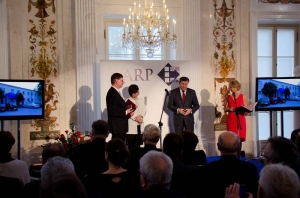ItraPol and LutaPol awarded by jury of the “Polish Product of the Future” competition
01-12-2014
Outcomes of the “ItraPol and LutaPol radiopharmaceutical precursors for applications in oncological radiotherapy” R&D project completed recently in POLATOM, NCBJ Radioisotope Centre, include ItraPol and LutaPol, new radiopharmaceutical precursors. The developed precursors have been awarded with the “Polish Product of the Future” title (in the Scientific Institution category of the competition). They have opened up the way to innovative medicines capable to increases effectiveness of some cancer therapies. Shipments of the medicines to Polish oncology hospitals have already begun. New medicines have given patients with disseminated neuroendocrine tumours a new hope for life, since classical therapies applied so far are not satisfactory.
„Our research on ItraPol and LutaPol started in 2007. Our team of researchers has completed all phases of the R&D cycle from devising a concept, through design, tests, approvals, all the way up to implementing the results to production” – pointed out Associate Professor Renata Mikołajczak, Plenipotentiary of NCBJ POLATOM Radioisotope Centre Science Director – „New preparations belong to the so-called targeted therapy medicines: they precisely and efficiently look up in the organism and kill only cancer cells of some target type, being practically safe for other patient tissues. ItraPol and LutaPol are exemplary benefits one can draw from well-thought-out applications of ionizing radiation – in this case better protection of human life/health”.
Cancer researchers have shown that various types of cancer cells (e.g. neuroendocrine tumour cells) are equipped with receptors of specific types. The receptors capture from bloodstream specifically those hormones and/or proteins that are just needed by the cell. It turns out that one can design active molecules that will be preferentially captured by specific cancer cells. If such molecules will be combined with (chemically bound to) some suitably selected radioactive isotope, accumulation of the molecules inside cancer cells will cause the latter to be killed preferentially in respect to other cells in the host organism. Just that is the role played by ItraPol and LutaPol radioisotope preparations. The former contains itrium-90, a radioisotope that decays in 2.7 days (half-life time) emitting β-rays of maximum energy 2.27 MeV (range in soft tissues about 12 mm). The latter contains lutetium-177, a radioisotope that decays in 7.6 days emitting β-rays of maximum energy 0.5 MeV (range about 2 mm).
„Taking advantage of affinity of carefully selected active molecules to receptors of specific cancer cells and labelling them with β emitters one can design innovative radioisotope-labelled pharmaceuticals that are very efficient in fighting metastases. Such targeted therapies are helpful especially when cancer cells are disseminated all over the patient body” – explains Professor Renata Mikołajczak.
The 7.8 mln PLN worth 3-years long “ItraPol and LutaPol radiopharmaceutical precursors for applications in oncological radiotherapy” R&D project was co-financed by European Union (the Innovative Economy Operational Programme of the European Regional Development Fund). NCBJ researchers have developed a technique to produce the needed itrium-90 and lutetium-177 radioisotopes in MARIA, research reactor operated in Świerk. The produced preparations must have specific activity high enough for the therapy to be efficient, and must be pure enough (both chemically and in terms of foreign radionuclides) to be safe. A new ItraPol/LutaPol production line was put into operation already in 2013. After pilot batches have been successfully produced and verified, currently the line is used to manufacture the new preparations on the regular basis. It is expected that MARIA/POLATOM capacity will be sufficient to meet the whole domestic demand and export at least 50% of the produced quantities of ItraPol/LutaPol. Start of the deliveries has marked quite a new situation on commercial market of such preparations.
“Pilot batches of ItraPol/LutaPol produced on our new production line were the basis to register the new preparations in the Medical Products Registration Office.” – said Professor Grzegorz Wrochna, NCBJ Director General – “This year our preparations were officially admitted to trading, which was an indispensable pre-condition to bring them to the market. The lutetium-177 isotope was formally admitted for the first time in the world”.
Currently radiotherapy of neuroendocrine tumours is offered in only 8 oncology hospitals in Poland, but it might be available in all 63 Polish nuclear medicine institutes. According to Polish Society of Endocrinology, global incidence rate of endocrine tumours is 30 per 1 million population. It means that in Europe inhabited by approximately 577 million persons there are over 17 thousand new cases each year.
The “Polish Product of the Future” competition has been organized annually since 1997 by Polish Agency for Enterprise Development (PARP) under the honorary patronage of Minister of Economy. The competition is intended for innovative enterprises, research and development units, scientific institutes, research centres and also for individual inventors from EU Member States capable to demonstrate some innovative technology/product at the implementation or pre-implementation phase of development.





